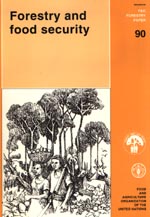 Forestry
and food security
Forestry
and food security
FAO FORESTRY PAPER 90
FOOD AND AGRICULTURE ORGANIZATION OF THE UNITED NATIONS
Reprinted 1991, 1996
The designations employed and the presentation of material in this publication do not imply the expression of any opinion whatsoever on the part of the Food and Agriculture Organization of the United Nations concerning the legal status of any country, territory, city or area or of its authorities, or concerning the delimitation of its frontiers or boundaries.
M-30
ISBN 92-5-102847-8
All rights reserved. No part of this publication may be reproduced, stored in a retrieval system, or transmitted in any form or by any means, electronic, mechanical, photocopying or otherwise, without the prior permission of the copyright owner. Applications for such permission, with a statement of the purpose and extent of the reproduction, should be addressed to the Director, Publications Division, Food and Agriculture Organization of the United Nations, Viale delle Terme di Caracalla, 00100 Rome, Italy.
© FAO 1989
1.1 Introduction: The concept of food security
1.2 Putting forestry in perspective
1.3 The links between forestry and food security1.3.1 Environmental links
1.3.2 Production links
1.3.3 Socio-economic links1.4 Opportunities for action
1.5 Setting the policy framework: new goals and approaches
Chapter 2: Environmental links between forestry and food security
2.1 Trees and the microclimate
2.1.1 Temperature and humidity
2.1.2 Shade
2.1.3 Moisture availability2.2 Windbreaks, soil erosion and food crop yields
2.2.1 Trees: barriers against erosion
2.2.2 Other benefits of windbreaks
2.2.3 Effects of windbreaks on crop yields2.3 Tree's role in preventing water erosion
2.4 Protection afforded by forests in critical or hazardous areas2.4.1 Unstable slopes
2.4.2 Coastal protection
2.4.3 Riparian forests
2.4.4 Areas prone to salinisation
2.4.5 Dune stabilisation2.5.1 The effects of forest cover on stream flow and groundwater levels
2.5.2 Forests and stormflows
2.5.3 Low flows2.6 Forests, sediment and water quality
2.7 Forests and the global climate
Chapter 3: Forestry and food production
3.3.1 Trees and shrubs within pastoral systems
3.3.2 Fodder production and nutritive value
3.3.3 Improved use of tree fodder
3.4.1 Trees and improvements to the soil
3.4.2 Nitrogen-fixing trees
3.4.3 Nutrient cycling in agroforestry systems
3.4.4 Possible detrimental effects of trees
3.5.1 Mangroves: support for coastal fisheries
3.5.2 Additional food products from mangroves
3.5.3 Pressures on mangrove ecosystems
Chapter 4: The socio-economic aspects of forestry and food security
4.1 The dietary role of forest foods
4.1.1 Forest foods as a dietary supplement
4.1.2 Trees and forests as seasonal food resources
4.1.3 The emergency role of forest foods4.2 Changing diets
4.3 Fuelwood and household nutrition
4.4 Forestry and disease
4.5 Income and employment from forests4.5.1 Gathering enterprises
4.5.2 Processing enterprises
4.5.3 Employment in forest-based activities
4.5.4 The importance of forest-based enterprises for women
4.5.5 Contribution to household food security: the role of forest-based income
4.5.6 Constraints to further development of forest-based enterprises4.6 Farm trees: contributions to household food security
4.6.1 Home gardens: intensive tree management
4.6.2 Trees as cash crops: the case of farm woodlots
4.6.3 Management of forest fallows
4.6.4 Farmers' incentives for tree growing
4.6.5 Tree cash crops and household food security
4.6.6 Trees as a form of insurance4.7 Land tenure and food security
4.7.1 Distribution of land-holdings
4.7.2 Ownership of trees4.8 Common property resources: assuring household food security
4.8.1 Diversity of common property systems
4.8.2 Externally-imposed common property systems
4.8.3 Building on existing institutions
Chapter 5: Opportunities for action
5.1 Setting the policy framework: diversifying forestry activities to meet people's needs
5.1.1 Defining policy objectives
5.1.2 Land-use policies: promoting sustainable uses
5.1.3 Holistic approach5.2 Institutions: support for food security objectives
5.3 Research priorities
5.4 Approaches5.4.1. Identifying the problems
5.4.2 Identifying target groups
5.4.3 Importance of women5.5.1 Diversifying forest management to incorporate locally valued products
5.5.2 Encouraging tree growing on farms
5.5.3 Supporting small-scale forest-based enterprises
5.5.4 Providing market support